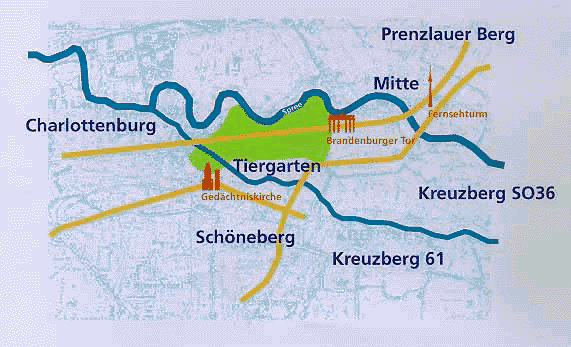netlounge Berlin | about
Berlin | hotels | scenes &
zones | abc
 A Brief Introduction to the Geography of Berlin
A Brief Introduction to the Geography of Berlin
Orientating yourself in Berlin isn't difficult at all. Berlin has three
prominent landmarks:
the Gedächtniskirche (Church of Remembrance), located on the Kurfürstendamm in the West,
the Brandenburger Tor in the city district of Mitte,
and the Fernsehturm (TV- tower) at Alexanderplatz in the East.
Round and about these three points of interest lie the inner districts
of Berlin. We have selected seven, each
with its own center and scene, to describe in more detail.
One friendly link, no ad: for a very recent update try https://triphappy.com/berlin/where-to-stay/47741
Charlottenburg:
Savignyplatz and its surroundings
The area around the Gedächtniskirche is the actual center of
the city: downtown Berlin. Even the fall of the Wall hasn' t changed
that. Luxury hotels and expensive boutiques line the Kurfürstendamm,
a broad boulevard better known as the "Ku'damm". In Charlottenburg,
the district north of the Ku'damm, you will find interesting and elegant
bookshops, cafés, bars and restaurants in the area around Savignyplatz.
Schöneberg: Winterfeldtplatz
and its surroundings
Berlin is still home to the alternative and "autonome" scene
- that means draft-dodgers (avoiding Germany's mandatory military service),
squatters and anarchists. Schöneberg is its middle-class, almost well-to-do
version. The scene here is lifestyle-conscious and hedonistic. The
area around Winterfeldplatz buzzes with trendy but moderately-priced cafés,
bars and restaurants. Motzstrasse, located nearby, with its many bars provides
a central gathering point for the gay community.
Tiergarten: the park
and its surroundings
This district is named after the large park located in middle
of Berlin, just west of the Brandenburger Tor. A walk through Tiergarten
goes hand-in-hand with a tour of Berlin's famous buildings and historical
sites. The "Siegessäule" (Victory Column), located
in the center of the park, provides a fantastic view of the City.
Kreuzberg 61: Bergmannstrasse
and its surroundings
Kreuzberg is Berlin´s most (in)famous district. This is the site
where squatters and police clashed and violent demonstrations took
place in Berlin's turbulent 70´s and 80´s. The western part
of Kreuzberg is called " Kreuzberg 61". Whoever has a look around
here will quickly realize: Kreuzberg 61 is indeed alternative and multicultural
- but not quite like the rough and gritty SO 36, the eastern
part of Kreuzberg.
Kreuzberg SO 36:
Oranienstrasse and its surroundings
SO 36 and Oranienstrasse had been, up until a few years ago, the
hot spot in Berlin. This was where squatters, punks and other left-wing
radicals rioted against the police, negatively called "Bullen"
(cops). Because of its large Turkish population, it is also thought of
as "Turkey's second largest city". Kreuzberg was also
center-stage for nightlife in Berlin. But, after the fall of the
Wall, a part of the scene wandered over to the East. At any rate, Kreuzberg
SO 36 is still one of the most exciting places in Berlin.
Mitte: Rosenthaler Strasse
and its surroundings
Mitte is the historical center of Berlin. Important buildings, such
as the "Brandenburger Tor", the "Reichstag"
are to be found in this district. Since the fall of the Wall Potsdamer
Platz is Europe's largest construction site. The whole district
is being rebuilt into the new capital. But still, the northwestern part
of Mitte is the focal point for the scene. Dilapidated buildings, abandoned
factories and other ruins of the GDR which haven't been incorporated into
the regentrification boom, have been turned into the most unlikely bars
and clubs. Only an insider would be able to make his way through this
underground scene. Most of the action happens on Rosenthaler Straße,
and Oranienburger Straße (not to be confused with Kreuzberg's Oranienstraße).
Prenzlauer Berg:
Kollwitzplatz and its surroundings
Like Mitte, Prenzlauer Berg lies in former GDR territory. At that
time the area was settled by intellectuals, artists and anti-system deviants.
On account of the lower rents here, this hasn't changed even after the
fall of the Wall. The area has become a sort of melting pot which
is best exemplified in the cafés, restaurants and bars in the Kollwitzplatz
vicinity. It's calm but it's one of the most exciting parts
of Berlin, day or night.
netlounge Berlin | about Berlin | hotels | scenes & zones | abc
